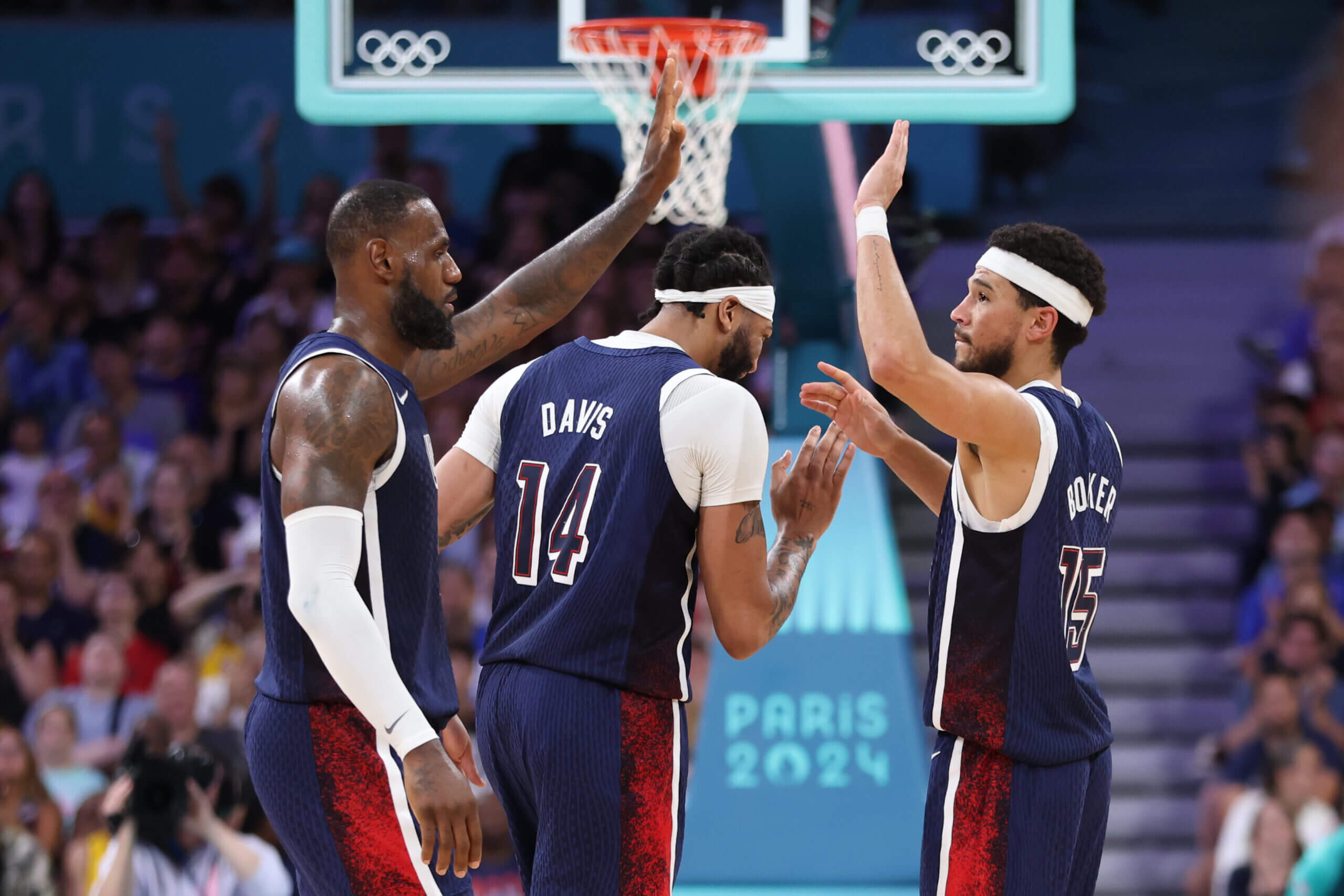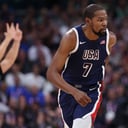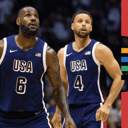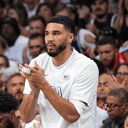
The saying in the NBA is that it’s a make-or-miss league, and apparently, the same applies to the Olympics. Entering Tuesday, the team that has shot better has won all six men’s basketball games, including Team USA’s torrid 62.3 percent shooting performance in a 110-84 rout of Serbia in its opener.
Through five tune-up games and the opener against Serbia, the overarching theme for the U.S. has been one of lights-out shot making offsetting some other deficiencies.
“Deficiencies,” of course, is a relative term. The Americans have won all six of their games this summer and on paper have far and away the most talented team. They also just reintroduced the greatest FIBA player of all time, Kevin Durant, to spectacular effect Sunday. The two upcoming group-stage games, against South Sudan and Puerto Rico, are unlikely to expose fatal flaws in this Death Star of a squad, so they should advance comfortably to the quarterfinals next week.

GO DEEPER
Kevin Durant takes all that fretting over his status and stuffs it in the hoop
Nonetheless, analyzing the data and going back to close calls against Australia and South Sudan in the exhibition schedule, one can perhaps see a scenario where the Americans might be vulnerable against one of the better teams in the medal round. (The quarterfinal opponent likely shouldn’t be too much trouble, although it’s still theoretically possible the U.S. draws Australia or Canada.)
While the data from the tune-up games in particular isn’t exactly Six Sigma accurate (two points appear to be missing from the Germany game, for instance), there’s enough information to dig deeper into where the Americans’ relative weaknesses lie.
Here are some trend lines that warrant scrutiny as the U.S. pushes further into the tournament.
The shot deficit
Team USA’s offensive attack has been insanely good so far, pumping in 114.5 points per 100 possessions in the five exhibitions and then ratcheting it up to a mind-boggling 130.3 against Serbia. That compares to a “league average” of 106.6 in the other five Olympic contests that had been played through Monday. The Americans posted a 60.1 percent true shooting mark in the tune-up games and 74.9 against Serbia.
However, one persistent fly in the ointment has been the Americans taking fewer shots than their opponent. Despite the athletic advantages the U.S. side would seem to have, the turnover and rebounding equations have both titled pretty heavily against it. The Americans had 17 turnovers against Serbia and only six offensive rebounds, and as a result, they had an eight-possession deficit in that game. The summer exhibitions saw a similar story, with a combined 22-possession gap in those contests (4.5 a game).
Most notably, the U.S. had a 12-possession gap in a close win against Germany to conclude the preseason tour, which is why the U.S. barely held on despite outshooting the Germans 50 percent to 36 percent.
Remember, FIBA games are only 40 minutes, and teams tend to average just 80 possessions or so (the U.S. plays crazy-fast relative to its peers, so it’s more like 84 when the Americans play and 77 for everyone else, but you get the idea). In that context, a gap of four to eight possessions is a bigger deal, putting a lot of pressure on the U.S. to outshoot the opposition.
Speaking of which…
Jedi 3-point defense
If there’s one way the U.S. seems most likely to suffer an upset, it’s with an outlier 3-point shooting game by its opponent. Thus far, however, it’s been almost the opposite: The U.S. has been pretty ordinary defensively in most respects but benefited from some wayward 3-point shooting by the opposition.
Team USA foes are taking nearly half their shots from the 3-point line — consistent with how most of the non-North American teams play in FIBA ball — but they made just 29.5 percent of them in the tune-up games. Serbia followed that up by going 9-of-37 from distance Sunday.
This is important to note, because the only reason the U.S. is trending even slightly above average on the defensive side of the ball is because of opponent 3-point shooting that seems highly likely to be random variance. It’s no accident the one game in which the trend line pointed the other way — against South Sudan, which shot 14 of 33 — the U.S. gave up 100 points and barely survived.

GO DEEPER
Dream Team dreaming: How great can this U.S. men’s basketball team still be?
While shot quality obviously matters (two of Serbia’s misses Sunday were end-of-quarter heaves, for instance), that doesn’t point much in the U.S.’s favor: Serbia generated eight corner 3 attempts Sunday and was fouled on another.
It’s not like the U.S. defense has been dominant in other respects, either. Serbia shot 60 percent on 2s and only had 13 turnovers, for instance. Including all six games, American opponents are shooting 49.6 percent inside the arc, almost matching the “league average” of 50 percent in the other five opening-round Olympic games from the weekend. What’s separating the U.S. from the competition right now is entirely on the offensive end.
Figuring out FIBA
As I wrote two weeks ago, Team USA’s biggest challenge in every international tournament is the team’s NBA stars adjusting to FIBA rules quickly enough that they are at less of a disadvantage by the medal rounds.
This is probably the area in which the U.S. team’s progress — and experience — has been most notable. The Americans on Sunday took 32 of their 69 shots from 3 and knocked down 18 of them, a far cry from the Germany exhibition where it seemed as if the two teams were playing a different sport (Germany took 45 3-point attempts to the U.S.’s 17); however, note that the U.S. has struggled to generate 3s against every opponent except Serbia, with the two highest outputs being the previous exhibition game against Serbia and Sunday’s opener.
The U.S. has been efficient enough inside the arc that it doesn’t have to take a ton of 3s, but as Sunday showed, it can definitely provide a glide path to victory. Getting players like Joel Embiid, Devin Booker and Anthony Edwards off the tough-2 express they’re forced to ride with their NBA teams and into a more role player-ish shot diet can play a big part. Booker had a meh exhibition season but on Sunday took only one midrange jumper and made four 3-pointers; LeBron James had eight baskets inside the charge circle and only one long 2 on Sunday. (That’s also one reason this has perhaps been an easier transition for Anthony Davis than other players: For a superstar, he gets an unusually large chunk of assisted baskets.)
You can almost see the learning curve in action watching Embiid, especially, who was awful against Canada and has slowly tried to find the beat since; while the narrative on him has perhaps been a bit too harsh the last couple games (he’s playing all his minutes against starters and setting road-grader screens for Stephen Curry), he’s probably going to be more valuable for the U.S. in his next FIBA tournament as opposed to this one.
On the sideline, Steve Kerr is figuring all this out at the same time, obviously, both in terms of how to use the roster (including the brave decision to DNP Jayson Tatum) and what works in international ball. Optimizing the shot mix is perhaps the most visible manifestation but hardly the only one.
In that sense, at least, the U.S. now has reserves of experience to draw on: This isn’t the first FIBA rodeo for Kerr, nor James, Durant, Jrue Holiday, or several other American players, and they’ve generally been the best performers.

GO DEEPER
Tatum ‘will play’ for Team USA vs. South Sudan after Sunday benching, Kerr says
Summing it up
The combination of overwhelming front-line talent and ridiculous depth probably means the U.S. eventually earns gold. But beware that the Serbia blowout may have been something of a sugar high achieved through outlier 3-point shooting by both sides. There are enough FIBA-specific warts from the early games that we can’t call this a 1992-esque coronation just yet, especially if the U.S. continues to battle a persistent shot deficit.
Much like the NCAA Tournament, the single-elimination format in the medal round gives everyone a puncher’s chance, and the U.S. will have to continue progressing before opponents like Germany and Canada — the two teams that beat the Americans in the World Cup a year ago — likely await in the knockout stage. The Serbia win was a fantastic opening salvo, but it doesn’t get real until next week.
(Top photo of LeBron James, Anthony Davis and Devin Booker: Gregory Shamus / Getty Images)